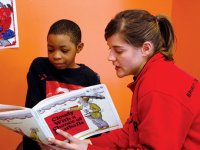Fostering Adaptive Teaching Across Reading Dimensions
Needs and Responses
As a reading instructor and former elementary school teacher, I understand the importance of instructors learning to respond to students' needs and interests. To foster adaptive teaching, I provide opportunities for preservice teachers to work with individual students through tutorial experiences embedded in my methods course, BEDUC 410: Knowing, Teaching and Assessing in Reading, Writing and Communication. During part of six class sessions, my preservice teachers meet one-to-one with third grade student buddies at a local school and engage in informal reading conferences to explore five dimensions of reading.
The reading dimensions, assembled by my colleague Nancy Place, are drawn from a report of the National Reading Panel and research on culturally responsive instruction:
- Word identification
- Comprehension
- Fluency
- Vocabulary
- Ownership
I teach the five dimensions through readings and class discussion, connecting concepts with preservice teachers' field placement experiences. Class texts include Reading Essentials by Regie Routman and I Read It But I Don’t Get It by Cris Tovani, with supplemental articles mostly drawn from The Reading Teacher, published by the International Reading Association.
After each tutorial session, the preservice teachers analyze information gathered about their buddies' reading skills and interests, and then record their experience in journals. Reflective journal entries are then used to write notes to the third grade classroom teacher regarding what they've noticed about their buddies' reading skills across the five dimensions.
Thinking Through the 5 Dimensions of Reading During Tutor Sessions
What follows is a brief description of each dimension and examples of how my preservice teachers explore them with their buddies.
Word Identification
To assess their buddies' word identification skills, each preservice teacher administers a list of increasingly difficult words from the Qualitative Reading Inventory and the Fry Word List so that my methods students can see the kinds of phonics skills children confuse and how unknown words are approached. Kate noted about her buddy, David, "He was determined to finish those lists! Even when he got to more difficult words, he tried each one, sometimes only getting the initial letter correct." Thus, Kate saw that David's word-reading skills were roughly at grade level, and that his determination to finish a task was remarkable.
Fluency
To gauge fluency, preservice teachers audio record their buddies reading aloud from a grade-level passage. Back in class, we calculate Words Correct Per Minute (WCPM) using established norms, and we use an Oral Reading Fluency Scale to gauge expressive reading. Craig's buddy, Sarah, read very quickly but without expression. "She reads like a robot -- a fast one! She hardly takes a breath!" For a follow-up activity, Craig decided that he and Sarah would jointly read "Somebody Has To," by Shel Silverstein, to help Sarah read with expression and pay attention to punctuation marks.
Comprehension
Background knowledge, text complexity, practice using strategies, and opportunities to read independently all directly impact how and to what degree students make sense of what they read. I help my preservice teachers formulate questions about main ideas, character development, retelling events or predicting future ones. Tutorial conversations help preservice teachers understand ways in which meaning is constructed from text, and what key reading comprehension strategies they should model and practice. Janet, reflecting on several conversations with her buddy, noted, "She could retell events from the story, but she was confused about why characters behaved the ways they did. I can tell she understands the basics but could benefit from strategies that will help her think more deeply about character motivation. I'd like to work with her on making inferences so that she can better understand what's going on in the story she's reading."
Vocabulary
Vocabulary takes considerable skill to assess and teach well. A lot depends on how much students read and how interested they are in learning new words. Stuart was surprised that his buddy, Jason, became puzzled over the events in a book -- one he seemed to be reading with ease -- due to a single word he misunderstood. In Frindle, by Andrew Clements, the term "royalty" is used in a publishing context. Jason, when asked about this term, described kings and queens and castles, though none of these things were in the book! Having discovered this misunderstanding, Stuart was able to explore "royalty" with Jason using an online dictionary, together identifying a meaning that fit the context in Frindle.
Ownership
Ownership is an overlooked yet important reading dimension that includes engagement, motivation and interests. Trisha was surprised that her buddy, Sandy, disliked fairy tales and other "silly" stories, preferring informational books about animals. So Trisha adjusted her approach by providing books and magazines about animals and nature, and Sandy's engagement and comprehension increased.
Trees in a Forest
By working with student buddies, my preservice teachers applied theory to practice, a process that helped them become adaptive teachers. One preservice teacher wrote that the exercise helped her appreciate "the different dimensions of reading and just how complex the process of comprehension is." Another wrote, "Once I had gathered all of the information about Ivan's reading skills, his needs became obvious, and it was clear to me what my focus should be when working with him."
Once they understood the skills and interests of a single child, each preservice teacher saw the importance of focusing instruction on the needs of readers rather than on following scripted curriculum materials. As one preservice teacher succinctly put it, "By examining a single tree, I better understand the forest."
